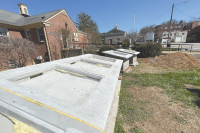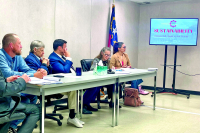Between the fingers lies the soul
 They all do something with their hands.
They all do something with their hands.
Meandering around Western North Carolina and greater Southern Appalachia, one thing becomes apparent — folk ‘round here are quite imaginative. It’s been said you can’t throw a rock in any direction without hitting someone with a zest for life coupled with a deep sense of the creative self.
When you dig below the surface of those around you, often you find they use their hands and fingers to express the soul within. Whether it’s hummingbird finger-pickin’ up and down the fret board of a bluegrass instrument or seamless paintbrush strokes on a blank canvas, hammering away at hot metal or taking a lump of clay and molding each into an item of use, what remains is a singular culture that taps into its wide-ranging physical and emotional strengths.
And showcasing the talents and rabbit hole nature of one’s creative self, there are countless art and craft festivals held every season in an array of mountain towns around our region. Of which, the Heritage Arts Summer Festival will once again take place on July 16 at Southwestern Community College in Bryson City.
The event is an extension of the SCC Ceramics Arts Club, a student-run group that brings together local artisans, musicians, cloggers, and the curious alike.
Related Items
Evie Auerbach — Ceramics, Sculpture
Originally from New Jersey, Auerbach remembers the spark of creativity igniting within her at a young age.
“Listening to beautiful music and the sounds from nature were the beginnings of my connection to art,” the 62-year-old said. “And an encounter at the age of five with a circus elephant aroused my fascination with exotic creatures. Watching cartoon animation also sparked my imagination.”
Eventually, she was invited to try out clay art by a potter working at the Liberty Village Artists collective in Flemington, New Jersey. A designer at heart, she found clay to be quick and expressive, something that tied in well with her passion for experimentation. In 1978, she found herself running the Georgia Tech student crafts center. She used the equipment at the university and taught herself how to throw a pot, operate a kiln and make glazes.
“Two years after learning the basics, I was selling my wares at the student center holiday fair and discovered that people love to buy pottery,” Auerbach said. “This is when I realized it was a viable way to make money and be creative at the same time. It was also at Georgia Tech some 34 years ago that I created my elephant oil lamps, and to this day I’m still making them.”
Relocating to Glenville in 1983, Auerbach views the natural beauty of the landscape and its people as her biggest inspiration.
“I spent a mere 30 years on that mountain top waking up to its serene and majestic beauty and peace and quiet it was quite the place to work as an artist — the imagination cuts loose in wide-open spaces,” she said. “Art should be a spontaneous experience whereas craft is more work at it and get it right. I sure put my years in learning the craft of ceramics, but found my most enjoyment came when each piece created was one of a kind. Being awake to the endless possibilities with clay guided me to the unique character I could express in the dog sculptures. All of the characters (in Western North Carolina) are what make a serene and beautiful place different and I found it rewarding to come to know all of the unique people.”
And what about the place of art in the 21st century?
“The human touch really cannot be substituted by the machine, so yes, education on what handmade is continues to be vital as so many today have no idea how things are made,” Auerbach said. “If we lose the unique character of hand made objects, we lose our individual character and the ability to express ourselves.”
Jason Rizzo — Fine Art Photography
It was a trip to Mexico City when he was six years old that kick started Rizzo’s love of photography.
“That was the beginning of traveling extensively throughout my life and wanting to capture the emotions and beauty of the scenes and places I was lucky enough to experience all over the world,” he said. “A few years later, I would soon get my own first camera, a Kodak Disc camera in the early 1980s, and my love of photography took off from there.”
After 18 years as a computer engineer, Rizzo was burnt out on his current existence. So, he quit his job and left it all behind in pursuit of his dream — photography. Now 44, Rizzo has spent his life in search of the perfect shot, an image that conveys not only emotion and a physical presence, but also the essence of the soul looking through the viewfinder.
“There is also the element of luck and surprise. I never know exactly what is going to happen when I go out shooting. There is never a guarantee that I head out one morning and am going to see a bear or a great bird shot or a magnificent sunrise. But when it does happen, it’s magical, because you are witnessing something that nature is allowing you to see,” he said. “Photography allows you to interpret these wildlife moments and landscapes with your own emotions combined with nature’s emotions, whether it be landscape or wildlife, to show how nature is living and breathing and we are all connected and hopefully help to teach about this beauty that surrounds us.”
With a keen focus on landscape and wildlife photography, Rizzo stresses the importance of the “leave no trace” policy put forth by all parks and nature lovers.
“While out in the field, my goal is to leave as minimal of a trace and disturbance of my passing through naturally wild settings as possible,” he said. “Respect for natural settings, natural wildlife behavior, and humane treatment of animals are more important to me than any photograph I could hope to capture by any other means. Teaching this respect and all that nature has taught me through my images is something I strive for.”
Like Auerbach, Rizzo also emphasizes the importance, perhaps more so now than ever before, that modern society embrace art, nature, and also the true potential of themselves in this all too big world.
“We are fast becoming a society that lives and breathes with our phones, tablets, computer screens and TVs. Our eyes are always pointed down assessing the information our digital devices show us about our jobs or who’s texting us or who’s killing who in some part of the world,” he said. “Art allows an escape from all of that. It’s a chance to turn off your phone or tablet, enjoy creativity, and learn about something new. A chance to step outside and see the beauty that is all around us. A chance to open your mind to things you might never have considered or thought possible. Art is another avenue to communicate your message on how to make the world a better place.”
Want to go?
The Heritage Arts Summer Festival will be held from 10 a.m. to 4 p.m. Saturday, July 16, at Southwestern Community College in Bryson City. Alongside works by SCC pottery students, there will also be regional artists featured, live music, clogging, food, and more.
Admission is free. 828.366.2000 or ncheritageartsfestival.wordpress.com/summer.









